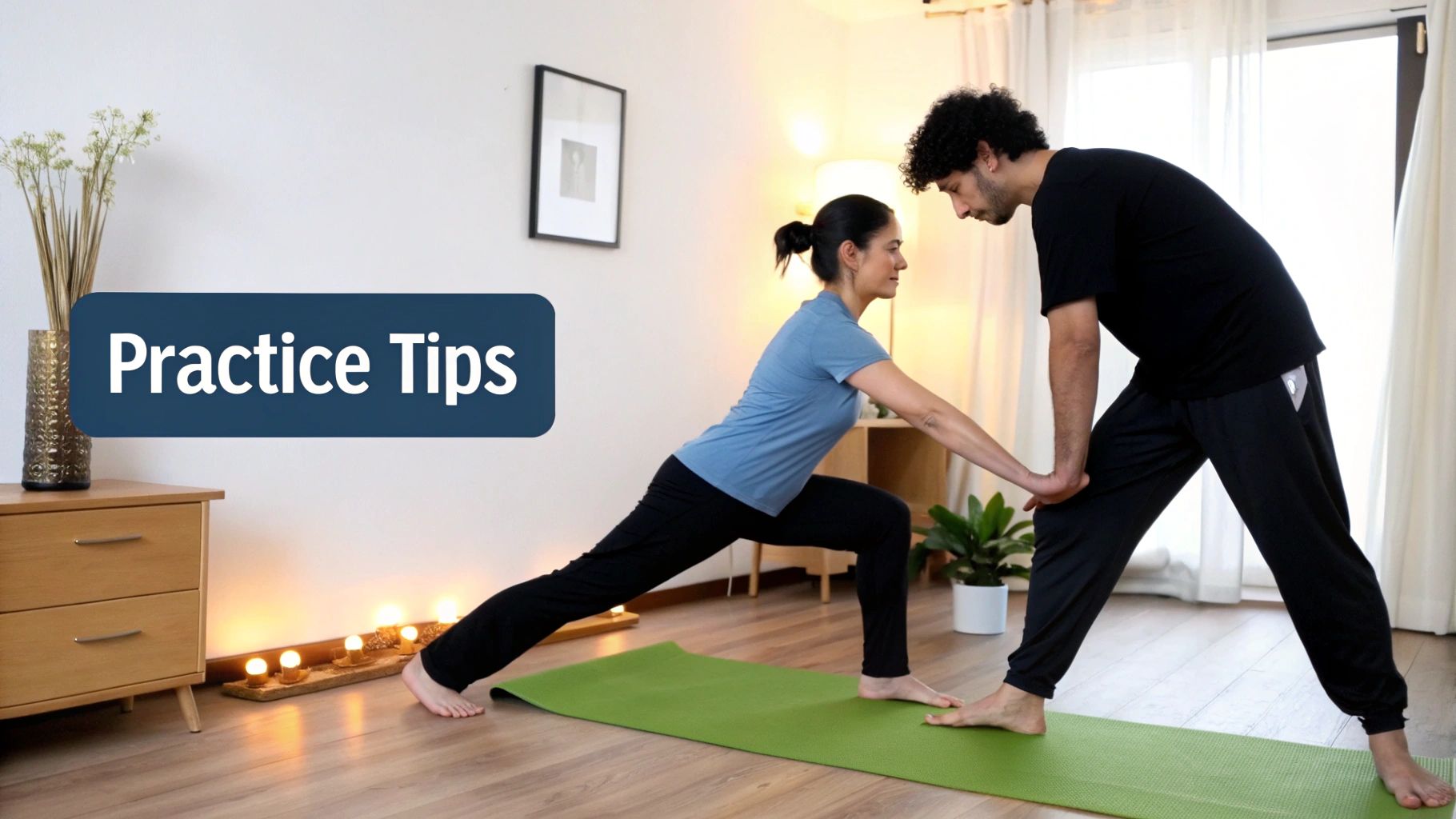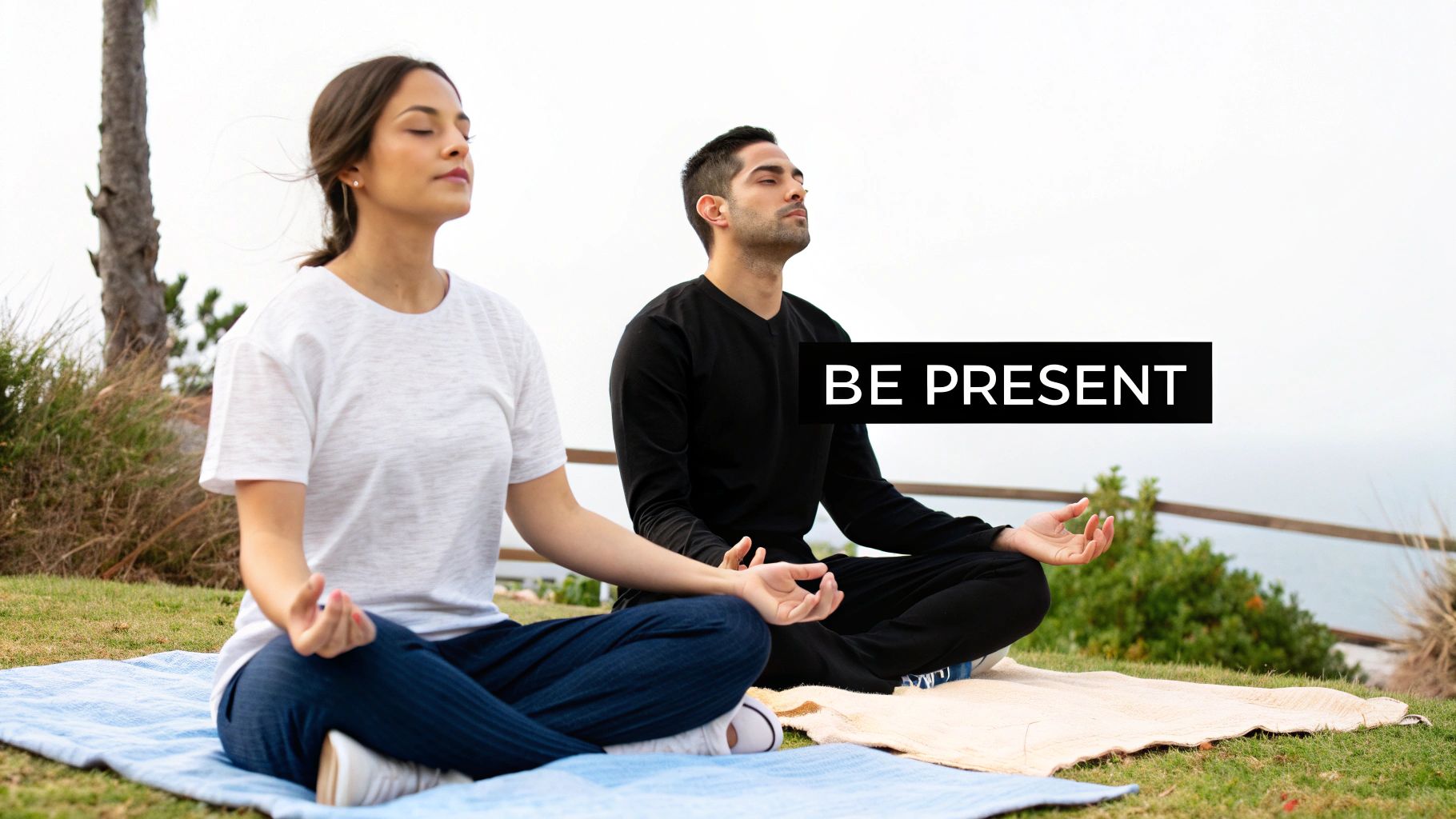How to Overcome Performance Anxiety: Expert Tips

Understanding Your Performance Anxiety: Why Your Mind Rebels
That familiar flutter in your stomach, the racing heart, the sudden blank mind – we all recognize the signs of performance anxiety. But why does our mind seem to betray us when we need it most? It comes down to a complex interaction between our psychology and physiology. Performance psychologists who work with everyone from Olympic athletes to Broadway stars emphasize that these reactions aren't just nerves. They're deeply rooted evolutionary responses.
Imagine our ancestors encountering a predator. Adrenaline would surge, preparing them for "fight or flight." We experience this same physiological response when facing a high-stakes performance. This means your anxiety isn't a weakness, but a natural reaction to perceived pressure. However, performers often process stress differently. While some crumble, others learn to channel this heightened state into focused energy.
Anxiety is increasingly common, affecting people in all areas of life. Globally, the prevalence of anxiety disorders increased from 3.7% in 1990 to 4.4% in 2021. This includes the realm of sports, where anxiety affects between 30% and 60% of athletes. These athletes may experience physical symptoms like shortness of breath, or mental symptoms like a sense of impending danger. You can find more detailed statistics here: Global Anxiety Statistics.
The Performer's Paradox: Anxiety as Fuel
High-achievers often learn to harness their anxiety, using it to enhance their performance. This is the performer's paradox: the feeling that threatens to derail them becomes their source of power. This transformation is possible through understanding and reframing anxiety.
Recognizing Your Anxiety Patterns
Understanding starts with recognizing your individual anxiety patterns. What triggers your anxiety? Do you experience physical symptoms, like trembling hands, or mental symptoms, like negative self-talk? This self-awareness is the first step in transforming your experience and management of performance anxiety.
By understanding your body's anxiety signals, you can go from being controlled by anxiety to interpreting its messages. This allows you to take control of your performance and reach your potential, turning a former obstacle into an advantage.
Recognizing Your Anxiety Signals Before They Overwhelm You

Taking control of performance anxiety begins with understanding your personal anxiety fingerprint. This means recognizing the small signs your body and mind send before full-blown anxiety takes over.
Perhaps you notice a tightening in your jaw, a shift in your breathing, or a negative thought taking hold. These subtle cues are early warnings, vital to managing anxiety before it escalates.
Identifying Your Personal Anxiety Fingerprint
Just like our physical fingerprints, our anxiety fingerprints are unique. Anxiety presents differently in each individual.
Some people experience primarily physical symptoms, like shaking hands or a rapid heartbeat. Others may have more mental or emotional symptoms, such as negative self-talk or a sense of dread. Identifying your unique anxiety fingerprint helps you address the root cause before it becomes overwhelming.
Differentiating Nervous Energy from Debilitating Anxiety
Pre-performance jitters aren't always bad. It's important to distinguish between productive nervous energy, which can actually improve performance, and debilitating anxiety, which hinders it.
Productive nervous energy might feel like excitement and anticipation. Debilitating anxiety, on the other hand, often leads to overwhelming fear and self-doubt. Recognizing this difference lets you harness the positive aspects of pre-performance excitement while managing the negative impact of anxiety. Many individuals experience anxiety disorders, which can affect performance across various fields. In the United States, approximately 19.1% of adults experience an anxiety disorder annually, with females more affected than males. Anxiety Disorder Statistics provides further information on this topic. Overcoming anxiety is especially critical in high-pressure environments.
Mapping Your Physical and Mental Responses
A helpful technique for recognizing your anxiety signals is to connect your physical reactions to specific thoughts. For example, if you feel your shoulders tense, what thoughts are accompanying that sensation?
By consciously linking your physical and mental states, you gain valuable insight into your anxiety triggers. This self-awareness is key to creating personalized strategies for managing performance anxiety. Journaling is another useful tool. It can help track your anxiety levels in various performance situations and identify recurring patterns. This allows you to anticipate and manage anxiety proactively, moving from passively experiencing anxiety to actively understanding its messages.
Rewiring Your Anxious Thoughts: Mental Strategies That Work

Transforming how you think about performance hinges on using specific mental strategies. These techniques are employed by top performers across diverse fields, from actors and musicians to athletes. They use these tools to manage and even harness the power of performance anxiety. This means you, too, can learn to rewire anxious thoughts and elevate your performance under pressure.
Visualization: Activating the Mind-Body Connection
Many professional athletes use visualization as a key part of their preparation. This involves mentally rehearsing the performance, meticulously imagining each step, and intentionally focusing on positive outcomes. Visualization is more than just wishful thinking.
Research suggests it activates the same neural pathways as physical practice, effectively priming both the body and mind for success. This mental rehearsal builds confidence and reduces uncertainty. This allows performers to approach the actual event with a stronger sense of control.
Thought-Challenging: Reframing Anxiety as Excitement
Public speaking is a common source of anxiety for many people. One highly effective strategy is thought-challenging. This involves identifying and questioning negative thoughts.
For example, instead of thinking "I'm going to mess up," a speaker might reframe that thought as "I'm excited to share my message." This shift in perspective can reframe anxiety as excitement, effectively channeling nervous energy into positive momentum.
Attention Control: Preventing Catastrophic Thinking
When anxiety takes hold, it's easy to slip into catastrophic thinking. Your mind races, conjuring worst-case scenarios. Attention control techniques can help break this negative cycle.
One such technique involves focusing on a specific sensory input, such as your breath or a physical object in the room. This redirects attention away from anxious thoughts, preventing them from spiraling out of control. By grounding yourself in the present moment, you regain mental clarity and composure.
Personalized Mantras: Building Confidence Under Pressure
Creating personalized mantras can be a powerful tool for managing performance anxiety. These short, positive affirmations can be repeated silently or aloud to bolster confidence and focus.
For instance, a musician might use the mantra "I am prepared. I am confident. I am ready." These personalized statements act as anchors, reminding you of your strengths and capabilities when the pressure builds. This can also be particularly beneficial in intimate situations, allowing you to concentrate on pleasure and connection instead of anxiety.
To further explore these techniques, the following table offers a comparison of different cognitive restructuring methods:
Cognitive Restructuring Techniques for Performance Anxiety
A comparison of different cognitive techniques and their effectiveness for various performance situations
| Technique | How It Works | Best For | Implementation Difficulty | Time to See Results |
|---|---|---|---|---|
| Visualization | Mentally rehearsing the performance, focusing on positive outcomes | Athletes, musicians, actors | Easy to Moderate | Varies, consistent practice is key |
| Thought-Challenging | Identifying and questioning negative thoughts, reframing them positively | Public speakers, presenters | Moderate | Can be immediate, but requires ongoing practice |
| Attention Control | Focusing on sensory input to redirect attention from anxious thoughts | Any performance situation | Easy | Relatively quick, effective in the moment |
| Personalized Mantras | Repeating short, positive affirmations to boost confidence | Any performance situation, particularly under pressure | Easy | Immediate, reinforces positive self-talk |
This table highlights the diverse applications and varying implementation difficulty of these techniques. While some, like personalized mantras, offer immediate benefits, others, like visualization, require consistent practice for optimal results. The key is to experiment and find what works best for you.
By mastering these mental strategies, you gain a significant advantage in overcoming performance anxiety. These are not just theories; they are practical tools you can use to transform your performance mindset.
Calming Your Body When Your Mind Can't: Physical Reset Tactics

When anxiety creeps in and threatens to disrupt your focus, addressing it physically can be surprisingly effective. This involves using your body to quiet the mental chatter, especially when thoughts are racing. Elite performers often employ physical reset tactics to regain composure in high-stakes situations.
These techniques are incredibly useful for interrupting anxiety and fostering a sense of calm.
Tactical Breathing: Regulating Your Nervous System
One of the fastest ways to calm your physical state is through tactical breathing. This isn't your average inhale and exhale; it's a specific method for regulating your nervous system. Performance coaches often highlight the significance of structured breathing patterns to quickly lower heart rate and encourage relaxation.
For instance, the 4-7-8 breathing technique involves inhaling for a count of four, holding for seven, and exhaling for eight. This rhythmic pattern helps transition your body from a state of anxiety to a state of tranquility.
Muscle Relaxation: Signaling Safety to Your Body
Another valuable physical tactic is muscle relaxation. This involves systematically tensing and releasing various muscle groups, beginning with your toes and moving upwards toward your head. This process helps alleviate physical tension and communicate a sense of safety to your nervous system.
It's like hitting the "reset" button for your body, dissolving accumulated stress and promoting relaxation. By concentrating on the physical feelings of tension and release, you shift your attention away from anxious thoughts and cultivate physical ease.
Pre-Performance Rituals: Priming Your Body for Excellence
Many top performers establish pre-performance physical rituals to prepare their bodies and minds for peak performance. These routines often incorporate activities like light stretching, a personalized warm-up, or even listening to a specific piece of music. These actions can act as anchors of assurance, signaling to your body that you are prepared.
They serve as mental cues, linking the ritual with successful past performances and diminishing the uncertainty that can contribute to anxiety.
Small Adjustments, Big Impact: Posture and Facial Expressions
Even minor physical adjustments can have a significant impact. Standing tall with open shoulders can enhance confidence and diminish anxious feelings. Similarly, a genuine smile, even if initially forced, can trigger the release of endorphins and elevate your mood.
These subtle shifts can create corresponding changes in your mental state. This is commonly known as the mind-body connection, where physical actions influence mental and emotional well-being.
Body Scanning: Identifying and Releasing Tension
Body scanning is a mindfulness practice that allows you to pinpoint and release tension before it escalates. This involves directing your attention to different parts of your body and observing any sensations without judgment.
By becoming aware of areas holding tension, you can actively release it through deep breaths or muscle relaxation. This proactive approach to tension management prevents it from developing into overwhelming anxiety.
Building Your Anti-Anxiety Toolkit for Long-Term Success
Overcoming performance anxiety isn't a quick fix. It's about building true, lasting resilience. This means developing personalized strategies to manage anxiety effectively over the long haul. You'll move beyond simply coping and start proactively thriving under pressure.
Strategic Exposure: Gradually Desensitizing to Pressure
Just like confronting a fear of heights, strategic exposure to performance situations can desensitize you to pressure. This means gradually increasing the intensity of your performance experiences.
For example, if public speaking makes you anxious, start by practicing in front of a mirror. Then, try presenting to a small group of friends or family. As you become more comfortable, gradually increase the size of your audience.
Mindfulness Training: Cultivating Calm Amidst the Storm
Many top performers use Mindfulness Training as part of their daily routines. Mindfulness is about paying attention to the present moment without judgment. This practice helps you become more aware of your anxiety triggers. You'll learn to observe anxious thoughts without getting carried away.
This means developing greater control over your mental and emotional state. You'll navigate challenging situations with more composure.
Deliberate Practice: Building Pressure Resistance
Deliberate practice is more than just repetition. It involves focused, structured practice sessions targeting specific areas for improvement. This approach builds resilience against pressure. By consistently practicing under challenging conditions, you train your mind and body to perform effectively, even when anxiety arises.
This allows you to become less reactive to pressure. You’ll access your skills more readily when it truly matters.
To understand the effectiveness of different approaches, let's look at some data:
Effectiveness of Long-Term Anxiety Management Approaches
The following table shows statistical data on the success rates of different long-term strategies for managing performance anxiety based on a compilation of research studies and expert opinions.
| Strategy | Success Rate | Time Investment | Professional Guidance Needed | Maintenance Required |
|---|---|---|---|---|
| Strategic Exposure | 70-80% | Moderate | Sometimes | Moderate |
| Mindfulness Training | 60-75% | Low | Sometimes | High |
| Deliberate Practice | 80-90% | High | Rarely | High |
| Cognitive Behavioral Therapy | 75-85% | Moderate | Usually | Moderate |
As you can see, Deliberate Practice often yields the highest success rates but requires a significant time investment. Strategic Exposure also offers a good balance of success and time commitment. While Mindfulness Training may have a slightly lower success rate, it's often the easiest to implement and maintain. However, individual results may vary, and seeking professional guidance can be crucial for maximizing success with any of these strategies.
Professional Support: Knowing When to Seek Guidance
Self-help strategies can be very effective. However, sometimes professional guidance is the best path. If anxiety significantly impacts your life, seeking support from a therapist or counselor specializing in anxiety can provide valuable personalized strategies and coping mechanisms.
This means having a trained professional to help you address your specific challenges and create a tailored plan. Resources like the Anxiety & Depression Association of America (ADAA) can help you find support.
Tailoring Your Approach: Recognizing Individual Differences
Different personalities respond differently to various resilience-building strategies. Some people might benefit more from cognitive techniques like thought-challenging. Others might find physical approaches like muscle relaxation more effective. Experiment with different methods to find what works best for you.
Tracking Your Progress: Building Momentum and Motivation
Tracking your progress is key for staying motivated and building momentum. A journal or tracking app can help you document your anxiety levels before, during, and after performance situations. This data will provide valuable insights into the effectiveness of your strategies. You can pinpoint areas needing more attention. Every performance, whether successful or challenging, becomes a learning opportunity. This continuous self-assessment will empower you to refine your anti-anxiety toolkit and build long-term success.
Perfecting Your Pre-Intimacy System: Practical Preparation

Feeling confident and comfortable in intimate moments often comes down to preparation. This involves understanding your partner's needs and being secure with yourself. This section explores a structured system for preparing for intimacy, helping to minimize performance anxiety.
Deliberate Practice: Mastering Intimate Moments
Just like athletes train for specific skills, deliberate practice can build comfort and confidence in intimate situations. This might involve exploring different positions, practicing open communication with your partner, or exploring self-pleasure to understand your own body. Focused practice reduces uncertainty and allows you to approach intimacy with greater ease.
Stress-Testing: Simulating Real-World Scenarios
Creating realistic simulations of intimate scenarios can lessen anxiety around the actual event. For example, if initiating intimacy feels daunting, practice bringing up the topic of desire with your partner in a non-sexual setting. This can build confidence and make the transition to the bedroom smoother.
Feedback and Adjustment: Addressing Your Concerns
Open and honest communication with your partner is crucial for overcoming performance anxiety related to intimacy. Feedback is invaluable for identifying areas for improvement. This might involve discussing anxieties, exploring different ways to give and receive pleasure, or even using relationship resources like Gottman Institute. This feedback loop creates understanding and refines your approach.
Personalized Pre-Intimacy Routines
Developing personal routines before intimacy can signal readiness to your mind and body. This could include a warm bath, relaxing music, or shared activities like cuddling or massage. These routines can establish a sense of calm and reduce stress, promoting relaxation and connection.
Contingency Planning: Handling Potential Issues
Having a plan for potential challenges during intimacy can alleviate anxiety. This might involve discussing alternative positions if one is uncomfortable, or having a strategy for reconnecting emotionally if anxiety arises. These pre-determined strategies provide a sense of control in unexpected situations.
Finding the Optimal Preparation Timeline
Finding the right amount of preparation is key. It's about balancing thoughtful planning with spontaneity. Too little preparation might increase anxiety, while too much can create pressure and unrealistic expectations. The right balance is individual and depends on your specific needs and preferences.
By using these practical preparation techniques, you can build confidence, reduce anxiety, and create more fulfilling intimate experiences. Remember, overcoming performance anxiety in intimacy isn't solely about physical techniques; it's about cultivating a positive and confident mindset.
Transformation Stories: How Real People Conquered Performance Anxiety
Overcoming performance anxiety isn't simply about understanding the theory; it's about seeing how those theories work in real life. Learning how others have successfully managed these challenges can be incredibly motivating. Exploring their individual paths, understanding their struggles, and celebrating their victories provides tangible proof that overcoming performance anxiety is achievable.
From Operating Room to Open Mind: A Surgeon's Story
Dr. Anya Sharma, a renowned cardiovascular surgeon, once faced debilitating anxiety in the operating room. The immense pressure of life-or-death decisions often left her frozen with fear. However, Dr. Sharma found that tactical breathing techniques, combined with visualization, helped her regain control. Before each procedure, she visualized a successful surgery, which calmed her nerves and sharpened her focus. This mental rehearsal, paired with controlled breathing, transformed her anxiety into a source of calm, focused energy.
Key Takeaway: Dr. Sharma's story demonstrates how combining physical and mental techniques can effectively manage anxiety.
From Stage Fright to Standing Ovation: A Musician's Journey
David Chen, a concert pianist, battled crippling stage fright for years. The mere thought of performing before a large audience filled him with dread. He found his solution through deliberate practice and strategic exposure. Starting with performances in smaller venues, David gradually increased his audience size as his confidence grew. He also meticulously rehearsed challenging musical passages until they became second nature. This consistent, focused practice, combined with incremental exposure to performance settings, allowed him to transform his fear into exhilarating performance energy.
Key Takeaway: David's journey emphasizes the benefits of gradual progress and the importance of building resilience through consistent, focused practice.
Conquering the Boardroom: An Executive's Transformation
Sarah Johnson, a corporate executive, dreaded presentations. The idea of speaking in front of her colleagues filled her with panic. She overcame this fear by using systematic desensitization and personalized mantras. Starting with small team meetings, she gradually worked her way up to larger presentations, using positive affirmations to bolster her confidence. She would repeat phrases like, "I am prepared, I am confident, I am capable." This combination of gradual exposure and positive self-talk helped her reframe her anxiety as excitement.
Key Takeaway: Sarah's story highlights the effectiveness of personalized strategies and the significant impact of positive self-talk in managing anxiety.
Turning Pre-Game Jitters into Performance Fuel: An Athlete's Story
Maria Sanchez, a professional tennis player, learned to transform pre-competition anxiety into a source of energy. She achieved this through muscle relaxation techniques and pre-performance rituals. Before every match, she engaged in a specific warm-up routine, followed by deep muscle relaxation exercises. This physical preparation, along with a consistent pre-game ritual, allowed her to channel her nervous energy into focused intensity.
Key Takeaway: Maria's experience shows the value of physical preparation and the positive influence of pre-performance routines in managing anxiety.
From Conference Fear to Academic Authority: A Professor's Story
Dr. Michael Lee, a university professor, struggled with presenting his research at academic conferences. He found his answer through mindfulness training and thought-challenging. He learned to observe his anxious thoughts without judgment, and to reframe negative self-talk into positive affirmations. This allowed him to approach presentations with a sense of calm and authority.
Key Takeaway: Dr. Lee’s story demonstrates the effectiveness of mindfulness in managing anxious thoughts and the power of thought-challenging in reframing negative self-talk.
These stories illustrate the various ways individuals have successfully overcome performance anxiety. They highlight the effectiveness of different techniques and the importance of discovering what works best for each person. They also underscore that overcoming performance anxiety is an ongoing process, not a single destination.
Want to learn more about understanding and overcoming performance anxiety in your intimate life? Visit G-Spot 101 for expert advice, personalized tips, and a supportive community. Empower yourself to create a more fulfilling and confident intimate life.








































